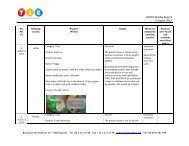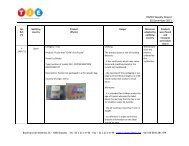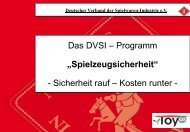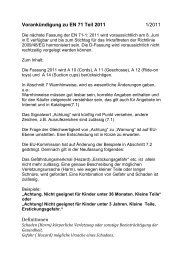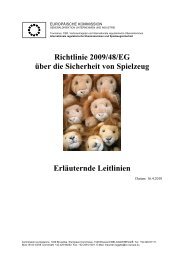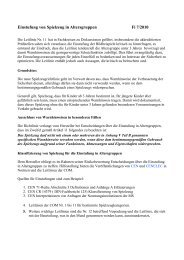Create successful ePaper yourself
Turn your PDF publications into a flip-book with our unique Google optimized e-Paper software.
A.11 Folding and sliding mechanisms (see 4.10.1)<br />
<strong>EN</strong> <strong>71</strong>-1:<strong>2005+</strong><strong>A8</strong>:2009 (E)<br />
These requirements are intended to address some but not all of the possible crushing, laceration and pinching<br />
hazards that might occur due to the sudden and unexpected collapse of folding toys whether intended to<br />
support the mass of a child or not.<br />
They are also intended to address the hazards associated with the child being trapped in a collapsing<br />
pushchair or perambulator, and with children getting their fingers jammed when playing with a toy.<br />
Fatal accidents are known to have occurred when toy pushchairs have collapsed and the handle has come<br />
down over the head or throat of the child when the child has been trying to sit in or climb into the toy pushchair.<br />
It is, therefore, necessary to require that such pushchairs or perambulators should be equipped with two<br />
separate locking and/or safety devices as is the case for full-size pushchairs and prams.<br />
Certain pushchairs are not designed with a handlebar that folds down over the toy when it collapses but folds<br />
together in a sideways direction. It has been agreed that such toys do not present the same severe hazard<br />
and consequently do not require two separate locking devices.<br />
However, it has not been considered possible to eliminate all possible jamming hazards of toys when they are<br />
folded together in their intended way. Manufacturers should reduce those hazards as far as possible, for<br />
example by allowing for a 12 mm clearance between moving parts and by using safety stops. Great care<br />
should also be used when designing toys with folding or sliding parts so that scissor-like actions of moving<br />
parts are avoided as far as possible.<br />
Items a), b), and c) of 4.10.1 cover toys that may collapse. Item d) refers to other toys with moving parts (e.g.<br />
excavating equipment on a ride-on tractor), and the requirement that these toys are intended for or capable of<br />
bearing the mass of a child excludes smaller toys.<br />
A.12 Driving mechanisms (see 4.10.2)<br />
These requirements are intended to address the laceration and puncture hazards associated with sharp<br />
edges and points being exposed if the toy has been damaged. They are also intended to address pinching or<br />
laceration by entrapment of fingers in holes, in winder keys or between the winder key and the body of the toy.<br />
Driving mechanisms should be enclosed in order to prevent jamming or crushing of fingers and other parts of<br />
the body. Toys that should be assembled by an adult are tested when assembled (see 4.2, assembly).<br />
Small mechanisms are excluded, such as in small cars which would have insufficient power to jam fingers,<br />
and where power may be checked with a finger or a pencil inserted into the mechanism.<br />
A mechanism would fail the requirement in this clause, were it to become accessible and the moving parts<br />
would be liable to jam the fingers or otherwise injure a child.<br />
A.13 Hinges (see 4.10.3)<br />
This requirement is intended to address the possible crushing hazard related to varying clearances along the<br />
hinge line, admitting fingers in one position of the hinged part but not in another.<br />
It is only applicable to hinged assemblies in which both parts have a mass of 250 g or more and where the<br />
hinged moving part could be construed as a 'door' or a 'lid'. For the purposes of this requirement, a door or lid<br />
can be defined as a closure of extended surface area with an extended hinge line. Other hinged parts without<br />
a significant surface area or hinge line would probably fall into the category of a folding mechanism (see<br />
4.10.1, parts moving against each other, folding and sliding mechanisms).<br />
The requirement relates to the entrapment of a finger and injury through squashing between edges along the<br />
hinge line and between surfaces parallel with the hinge line as shown in Figure 1 (see 3.21, hinge line,<br />
definition) but not between other edges and surfaces of the assembly. There is only concern with the<br />
79



